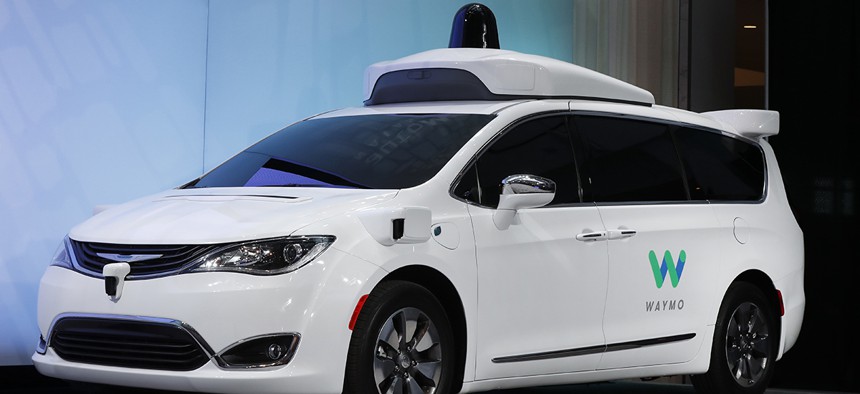It’s Getting Harder And Harder to Tell a Self-Driving Car From a Regular One

A Chrysler Pacifica hybrid outfitted with Waymo's suite of sensors and radar is shown at the North American International Auto Show in Detroit, Sunday, Jan. 8, 2017. Paul Sancya/AP
As with smartphones, digital cameras, and most other technology, when demand increases, the size of the sensing technology gets more compact.
In the near future, when you see a car out on the road—perhaps driving a little slower than you’d like—it’ll be pretty difficult to tell whether a human or a robot is driving it.
It’s relatively easy to spot which cars are self-driving now: Most of the technology that helps these cars navigate the world sticks out from their exteriors. There are radar systems, laser-radar sensors (called lidar), antennae and regular video cameras that sit atop them or are strapped to doors or bumpers. These bulbous extrusions have made self-driving cars tested in public obvious—like the early offerings from Google and Uber.
But as with smartphones, digital cameras, and most other technology, when demand increases, the size of the sensing technology gets more compact. Today, Velodyne, one of the leading manufacturers of lidar systems, unveiled a new sensor that can be embedded in future self-driving cars, or other vehicles with driver-assist technology. Velodyne’s early sensors were large, bucket-shaped, spinning machines that sat atop both Google and Uber’s cars. The company’s new sensor doesn’t look much larger than an indicator light:

With low-profile sensors like these, it’ll be more difficult to discern which vehicles are robots, and which are driven by humans. It’s happening even now: Tesla’s Model S has an “Autopilot” mode that theoretically allows the car to drive itself in simple highway situations, using only cameras built into the fenders and body of the car. (Then again, the technology was at the center of discussion in fatal crashes for Model S cars last year, and is probably not ready to be relied on.)
If self-driving cars can drive as reliably and proficiently as the average human driver, it may not matter we can’t discern which is which. But that’s not the case right now: Many of the autonomous vehicles being tested on public roads do not behave like human drivers (they’re often compared to timid student drivers just learning the rules of the road), and they’re getting into a fair number of accidents.
Drivers will likely want to know which cars are autonomous; they may have to relay on whatever sort of paintwork the company behind the self-driving cars has designed. The paintwork on Uber’s new self-driving Volvos doesn’t really make it clear it’s a self-driving car, and neither does that on the new fleet of minivans from Waymo (Google’s recently spun-out autonomous car company) hitting the road soon.
It will likely be years—possibly even decades—before we have reliable autonomous vehicles on the road. In the intervening time, when all the sensor technology becomes small enough to embed into a regular-looking car, the onus will fall on the companies trying to develop these vehicles to make it clear to drivers, bikers, pedestrians and whoever else might come into their paths, that these are giant robot vehicles that might not behave as expected.
NEXT STORY: NASA 3-D Printed Its Own 'Space Fabric'





